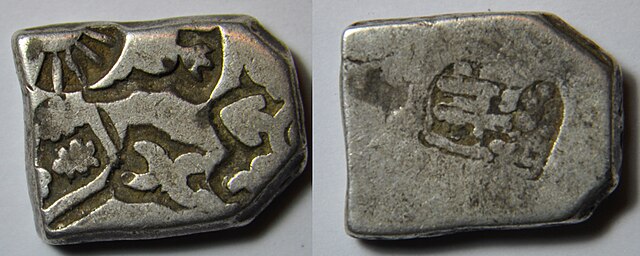Bindusara was the second Mauryan emperor of Magadha in Ancient India. The ancient Greco-Roman writers called him Amitrochates, a name likely derived from his Sanskrit title Amitraghāta.
A silver coin of 1 karshapana of the Maurya empire, period of Bindusara Maurya about 297–273 BC, workshop of Pataliputra. Obv: Symbols with a Sun Rev: Symbol Dimensions: 14 x 11 mm Weight: 3.4 g.
An inscription at Temple 40 in Sanchi suggests Bindusura may have been connected to its construction and to Buddhism. 3rd century BCE
Conjectural reconstruction of timber-built Temple 40 in Sanchi.
The Maurya Empire was a geographically extensive Iron Age historical power in South Asia based in Magadha. Founded by Chandragupta Maurya in 322 BCE, it existed in loose-knit fashion until 185 BCE. The empire was centralized by the conquest of the Indo-Gangetic Plain; its capital city was located at Pataliputra. Outside this imperial centre, the empire's geographical extent was dependent on the loyalty of military commanders who controlled the armed cities scattered within it. During Ashoka's rule, the empire briefly controlled the major urban hubs and arteries of the Indian subcontinent excepting the deep south. It declined for about 50 years after Ashoka's rule, and dissolved in 185 BCE with the assassination of Brihadratha by Pushyamitra Shunga and foundation of the Shunga dynasty in Magadha.
Pataliputra, capital of the Mauryas. Ruins of pillared hall at Kumrahar site.
The Pataliputra capital, discovered at the Bulandi Bagh site of Pataliputra, 4th–3rd c. BCE.
A silver coin of 1 karshapana of the Maurya empire, period of Bindusara Maurya about 297–272 BC, workshop of Pataliputra. Obv: Symbols with a sun. Rev: Symbol. Dimensions: 14 × 11 mm. Weight: 3.4 g.
Lion Capital of Ashoka at Sarnath. c. 250 BCE.






